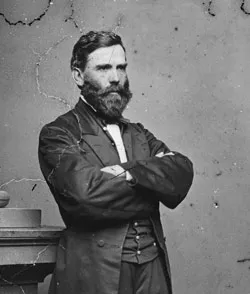A Deadly Crossroads


May 5 was a day of crisis for the Union high command. Shortly after Warren reported Confederate infantry advancing up the Turnpike, Crawford, at the Chewning farm, observed a second Confederate column headed up the Plank Road toward this intersection. This was a serious threat: if the Confederates gained possession of this point, they would drive a wedge between Warren’s corps, on the Turnpike to your right, and General Winfield S. Hancock’s corps, on the Catharpin Road to your left. Union troops needed to get here first and hold the intersection until Hancock arrived.
Meade assigned the task to General George Getty, who commanded a division in the Sixth Corps. Getty was a man of determination. He once claimed that if given an order to march his troops across the ocean, he would do so—or at least march until the water reached their chins and then report the order as impractical. Riding ahead of the division, Getty and his staff reached this point about noon, just minutes ahead of the Confederates. A staff officer raced back down the Brock Road to hurry the column along. Meanwhile, Getty and his staff unfurled their headquarters flag and took position in the center of the intersection, hoping to bluff the Confederates and buy time.
The ploy worked. The Confederates hesitated at the sight of Getty and his officers, allowing the Federals to reach the crossroads first. Around 4 pm, Getty attacked, his men tearing through the dense thickets in a vicious close-range fight. Hancock’s corps soon arrived and rushed forward to support Getty’s division. The woods shook with the rattle of musketry. As the casualties mounted, North Carolinians used Union corpses as breastworks. It was, recalled one Confederate, “a butchery pure and simple.” Nightfall—and exhaustion—ended the fighting. As soldiers lit their campfires, Grant made plans for renewing battle in the morning.






